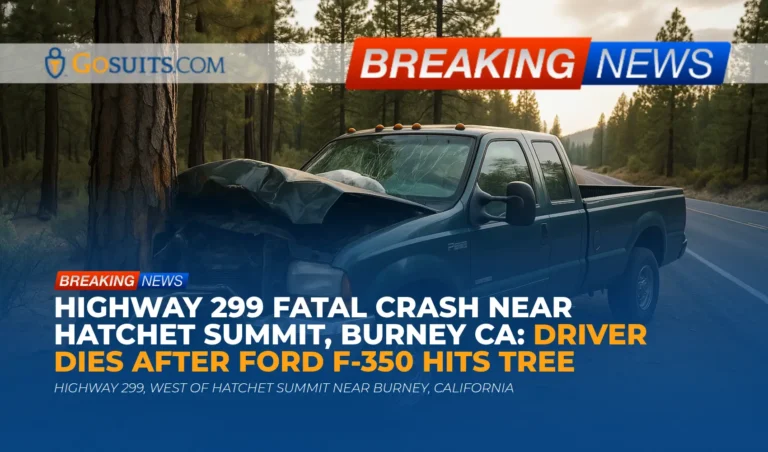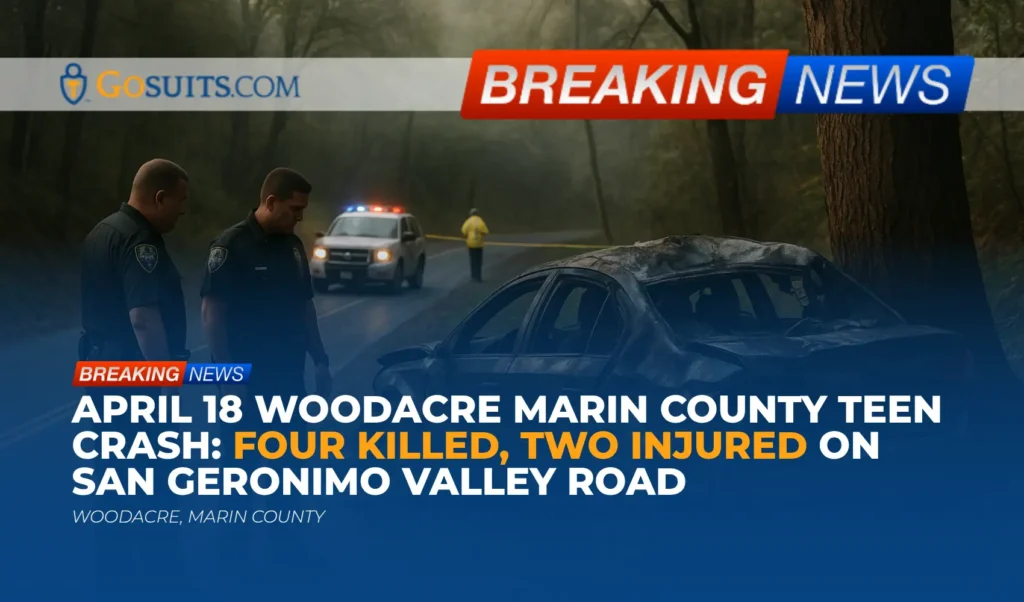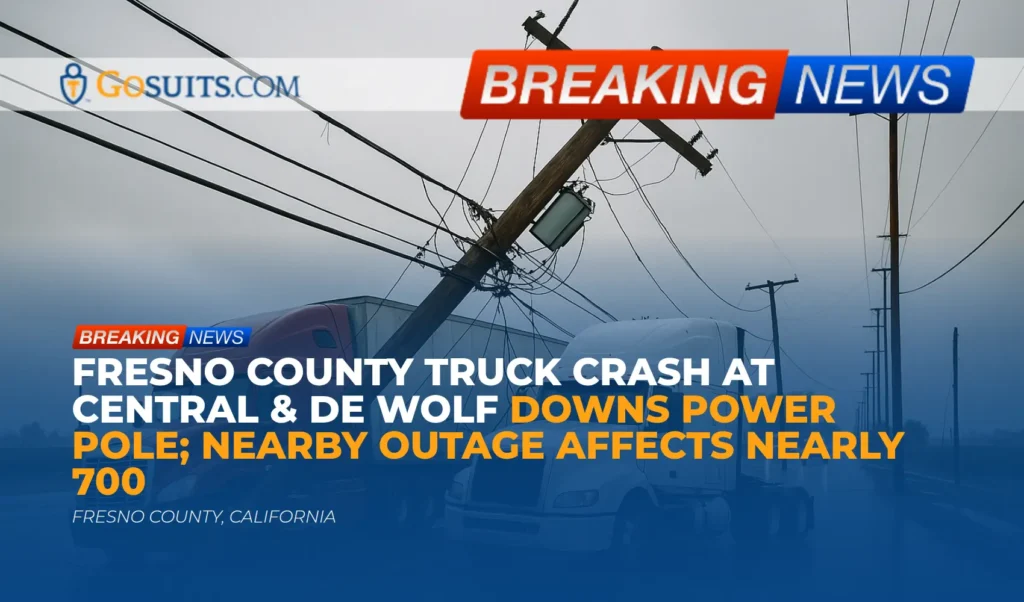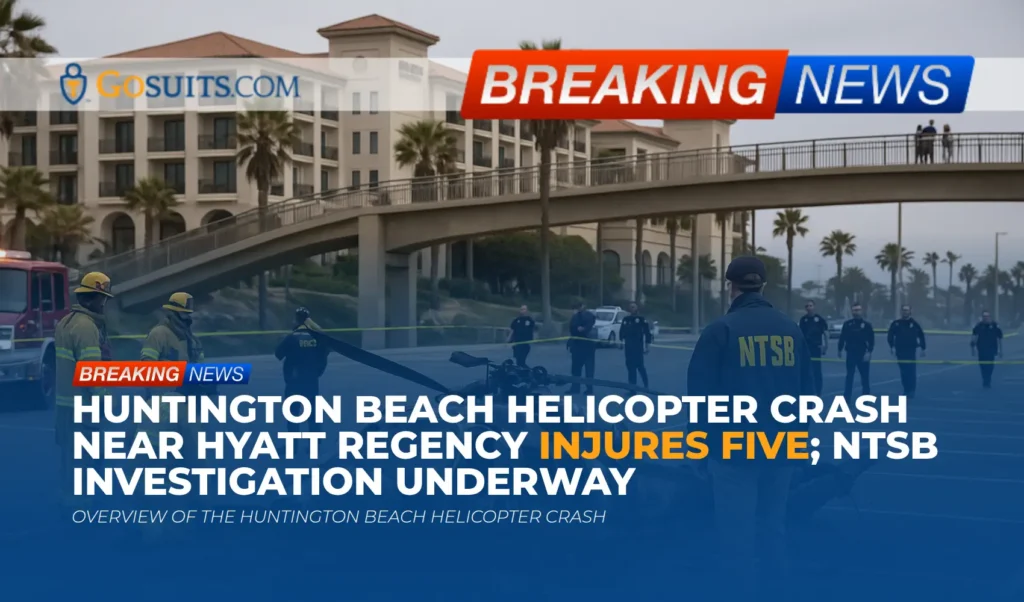- What We Know About the Highway 299 Fatal Crash Near Hatchet Summit
- Location Context: Highway 299, Hatchet Summit, and Burney
- Responding Agencies and What the Official Investigation Typically Involves
- How Families Can Obtain Key Records and Information
- Potential Civil Liability Pathways in a Single‑Vehicle Fatality
- Insurance Considerations After a Fatal Crash in California
- Preserving Evidence and Requesting an Independent Investigation
- Grief Support and Practical Resources in Shasta County
- Understanding Wrongful Death and Survival Actions in California
- What Safety Data Tell Us About Run‑Off‑Road Crashes
- Commentary from Gosuits Burney, California Personal Injury Attorney
- Call-to-Action: Time‑Sensitive Steps After a Fatal Crash in Shasta County
What We Know About the Highway 299 Fatal Crash Near Hatchet Summit
Authorities reported a fatal single‑vehicle crash on Monday afternoon, October 13, on Highway 299 west of Hatchet Summit near Burney, California. According to the California Highway Patrol, a man driving a green Ford F‑350 eastbound toward Burney left the roadway for unknown reasons and struck a pine tree. The driver was using a seat belt and the airbags deployed; he was pronounced deceased at 3:03 p.m. Responding agencies included the California Highway Patrol, Cal Fire, Shasta County Fire, and the Shasta County Sheriff’s Office. Officials indicated they do not suspect drugs, alcohol, or weather as contributing factors. The 2001 Ford F‑350 sustained major front‑end damage and was towed from the scene.
At this stage, the cause remains undetermined. In single‑vehicle crashes, investigators typically consider factors such as roadway conditions, mechanical issues, medical emergencies, animal avoidance, driver distraction, or an evasive reaction to another hazard. Until the collision report, scene analysis, and any mechanical inspections are complete, it is not possible to conclude what led to the loss of control. Our thoughts are with the family and community as they grieve and seek answers.
Location Context: Highway 299, Hatchet Summit, and Burney
Highway 299 is a major east‑west corridor crossing Shasta County and connecting communities such as Redding, Burney, and areas toward the northeastern Sierra‑Cascade region. The segment near Hatchet Summit includes forested terrain, elevation changes, and areas with limited shoulders. These features can increase the severity of roadway departure crashes, particularly when a vehicle leaves the pavement and impacts fixed objects like trees or embankments. For families trying to understand what happened, the geography of this corridor matters: curvature, grades, surface conditions, and sightlines can all play roles and should be accounted for in any reconstruction.
Responding Agencies and What the Official Investigation Typically Involves
In Shasta County, a fatal crash on a state highway generally involves a scene response by the California Highway Patrol (CHP) and local fire and medical services. The CHP leads the collision investigation, documents evidence, interviews witnesses if available, and prepares a formal collision report. The Shasta County Sheriff’s Office, through its Coroner’s Unit, manages the decedent’s examination and identification, and may order an autopsy and toxicology. The vehicle is typically towed to a storage facility pending next steps and potential inspection.
Key components often reviewed in a fatal collision investigation include:
- Scene evidence: tire marks, yaw marks, debris patterns, vehicle rest position, and any damage to roadside features.
- Vehicle condition: steering, brakes, tires, suspension, airbags, and possible mechanical failures.
- Human factors: medical emergency indicators, fatigue, distraction, or impairment if any is suspected.
- Environmental factors: roadway geometry, signage, lighting, roadway surface defects, and the presence of wildlife or obstructions.
Families typically receive updates as reports are finalized. Toxicology results and the coroner’s findings can take additional time depending on laboratory backlogs and case complexity.
How Families Can Obtain Key Records and Information
It can be painful to collect paperwork while grieving, but a few records are essential for understanding what happened and for handling legal and administrative needs. The following steps and sources are based on publicly available government guidance.
CHP Collision Report
The primary investigative document is the CHP Traffic Collision Report. Eligible parties may request a copy through CHP using the agency’s process for collision report requests. Instructions are available through the CHP’s portal: CHP Collision Report Request. The report typically includes diagrams, narrative findings, measurements, and contributing factor analysis, and it may note if further mechanical inspections or specialized analyses are pending.
Coroner’s Records and Autopsy/Toxicology
For Shasta County fatalities, the Coroner’s Unit of the Shasta County Sheriff’s Office oversees examinations, certifies cause and manner of death, and may conduct autopsy and toxicology testing when appropriate. Guidance for families on procedures and requesting records is available through the county’s official site: Shasta County Sheriff’s Office, Coroner Unit. Some records may be limited or redacted depending on investigative status and California law.
Death Certificates
Certified copies of the death certificate are necessary for many administrative tasks. The California Department of Public Health explains how to obtain certified copies and who may receive them: California Department of Public Health – Vital Records. Mortuaries often help initiate the process, but families can also request directly through CDPH or the county recorder.
DMV Accident Reporting (SR‑1)
California requires that many traffic crashes be reported to the Department of Motor Vehicles using the SR‑1 form within 10 days if anyone was injured or killed, or if property damage exceeds a statutory threshold. Information about submitting an SR‑1 is available on the California DMV website: California DMV. The DMV’s portal provides current requirements and online submission options.
Vehicle Location and Preservation
The vehicle is commonly stored at a tow yard or storage facility after a fatal crash. The storage provider may charge daily fees. Before authorizing disposal or repairs, families who are considering a civil claim often preserve the vehicle for inspection by qualified engineers or mechanics. A written preservation request can help prevent the loss of key evidence.
Dispatch Audio and 911 Records
Dispatch audio, 911 calls, and related logs may be obtainable through public records requests to the relevant agency, subject to exemptions. The specifics vary by agency and investigation status. Requests often reference California’s Public Records Act. Agencies can provide guidance on how to submit a request.

Potential Civil Liability Pathways in a Single‑Vehicle Fatality
Although single‑vehicle crashes may appear straightforward, civil liability can still arise from multiple sources. Each case is fact‑specific, and an in‑depth investigation is essential before drawing conclusions.
- Vehicle defect or component failure: Tires, steering, braking systems, or other components can fail unexpectedly. If a defect or negligent maintenance contributed, responsible parties can include manufacturers, distributors, or service providers. Vehicle inspections and, when available, data from onboard modules can help assess this possibility. The National Highway Traffic Safety Administration offers general information about event data recorders and vehicle safety research: NHTSA – Event Data Recorders.
- Roadway design, maintenance, or hazard conditions: Roadway departure crashes can be influenced by factors like inadequate shoulder recovery areas, poor signage, deteriorated pavement, or unaddressed roadside hazards. Where a state or local agency’s conduct is implicated, claims must be presented within specific time limits under California’s Government Claims Act. The statutory six‑month presentment deadline for personal injury or wrongful death claims against public entities is set out in California Government Code section 911.2: Gov. Code § 911.2. For claims involving state agencies such as Caltrans, see the Department of General Services claims information: California DGS – Claims, and Caltrans information regarding claims: Caltrans.
- Third‑party negligence: A sudden evasive maneuver to avoid an unsecured load, animal intrusion linked to nearby land uses, or another vehicle’s unsafe movement can lead to a departure from the roadway. Even if that other party did not make contact, liability can exist in certain circumstances if evidence supports their role.
- Commercial, employer, or fleet involvement: If the vehicle was employer‑owned or if the driver was engaged in the course of employment, additional legal frameworks may apply. Documentation of the trip purpose, vehicle maintenance logs, and company policies can become important.
None of these scenarios should be assumed in this case. Rather, they illustrate areas a careful investigation often explores in single‑vehicle fatalities.
Insurance Considerations After a Fatal Crash in California
Insurance questions can be overwhelming, and the answers depend on the policies in place and the eventual findings about fault or contributing causes. A few general points for awareness:
- Do not provide statements to insurers before legal guidance: In California, what is said to an insurance adjuster can be recorded and may be used later in a way that affects rights and recoveries. It is prudent to consult a qualified attorney first, at no cost, to understand options before speaking with any insurer.
- Auto coverage considerations: Policies may include medical payments coverage, accidental death benefits, or other optional coverages. These benefits and their coordination with other claims depend on the policy language.
- Uninsured/underinsured motorist (UM/UIM): Typically applies where another at‑fault driver lacks sufficient insurance. In some situations involving a “phantom” vehicle or an evasive maneuver caused by an unidentified motorist, UM coverage may be implicated, but this depends on the evidence and policy terms.
- Third‑party claims: If a dangerous roadway condition, negligent maintenance, or a defective product contributed, claims may be directed to a government entity, service provider, or manufacturer rather than the driver’s own liability coverage.
Insurance companies evaluate claims in ways that can minimize their payout exposure. Policy language, exclusions, and recorded statements can significantly influence outcomes. Careful review and cautious communications are important from the outset.
Preserving Evidence and Requesting an Independent Investigation
Independent investigation can complement official findings and help families understand what happened. Swift steps can prevent the loss of critical evidence.
- Preserve the vehicle: Send a written preservation request to the tow yard and any insurer with custody or control of the vehicle. Do not authorize disposal or repair until inspections are complete.
- Inspect and document: A formal mechanical inspection can assess steering, brakes, tires, suspension, and any component failures. Preserve removed parts in sealed, labeled containers to maintain chain of custody.
- Event Data Recorder (EDR): Some vehicles contain a module that records speed, braking, throttle, and other parameters around a crash event. Preservation and download require specialized tools and procedures. The NHTSA resource on EDRs provides general background: NHTSA – Event Data Recorders.
- Site review: Document signage, skid resistance, shoulder conditions, and visibility at and around the crash location. Photographs and measurements should note dates and conditions, as roadway features can change.
- Witness outreach: Identify and contact potential witnesses, including other motorists and nearby residents or businesses. The Highway 299 corridor may have traffic or security cameras at travel centers, lodging, or public facilities that temporarily store footage.
- Records requests: Seek maintenance logs, tree trimming schedules, or prior incident data for the roadway segment if a public entity’s role is being considered.
Grief Support and Practical Resources in Shasta County
Alongside the legal and investigative work, families often need practical and emotional support. Local and state resources can help with immediate needs and longer‑term coping.
- Shasta County Coroner’s Unit: Assistance with decedent release, autopsy status, and related questions is available via the Sheriff’s Office Coroner Unit: Shasta County Coroner.
- Death certificates and vital records: For certified copies and guidance on who can obtain them, consult the California Department of Public Health: CDPH Vital Records.
- Mental and behavioral health: Shasta County Health and Human Services provides information on services that may connect individuals to counseling and support: Shasta County Health and Human Services Agency.
- Traffic safety information: The California Office of Traffic Safety provides statewide safety data and programs that can offer context on roadway risks: California OTS.
Understanding Wrongful Death and Survival Actions in California
California law provides civil remedies that allow certain family members or a decedent’s estate to seek accountability when another party’s wrongful act or neglect contributes to a death. The frameworks differ depending on the claim type.
Wrongful Death Claims
California Code of Civil Procedure section 377.60 identifies who may bring a wrongful death claim, generally including a spouse or domestic partner, children, or others who were financially dependent on the decedent. The statute is available here: CCP § 377.60. Damages in a wrongful death claim are intended to compensate survivors for losses they suffer due to the death, such as loss of financial support and the loss of the relationship’s benefits. The exact scope is defined by law and the facts of the case.
Survival Actions
Separate from wrongful death, a survival action allows the decedent’s estate to pursue claims the person could have brought had they lived, for harms suffered before death. This framework is found in California Code of Civil Procedure section 377.30: CCP § 377.30. The types of recoverable losses and proof requirements differ from wrongful death claims.
Time Limits
California generally requires that wrongful death claims be filed within two years of the date of death, pursuant to Code of Civil Procedure section 335.1: CCP § 335.1. If a public entity is potentially at fault, a written government claim must typically be presented within six months under the Government Claims Act, as noted above in Gov. Code § 911.2. These deadlines can be outcome‑determinative, so prompt evaluation is important.

What Safety Data Tell Us About Run‑Off‑Road Crashes
Run‑off‑road and roadway departure crashes are a persistent source of severe and fatal injuries in the United States, particularly on rural and mountainous routes. Several safety themes are well‑documented by government sources:
- Roadway departure risk: The Federal Highway Administration highlights roadway departure crashes as a significant share of fatal crashes nationwide and promotes countermeasures like rumble strips, clear zones, and high‑friction surface treatments to reduce severity and likelihood. See FHWA’s Roadway Departure Safety resources: FHWA – Roadway Departure Safety.
- Seat belts and occupant protection: The Centers for Disease Control and Prevention note that seat belt use reduces the risk of death and serious injury for front‑seat occupants. See CDC’s overview of motor vehicle safety: CDC – Seat Belts.
- Vehicle technology: Airbags and modern vehicle structures are designed to mitigate injury, but high‑energy impacts with fixed objects can overwhelm protective systems. NHTSA’s research pages include information on safety technologies and crash data systems: NHTSA – Research & Data.
Context matters greatly. Features like shoulder width, roadside clearance, presence of guardrails, and pavement friction can influence whether a roadway departure results in a survivable event. This is why site‑specific documentation and, where appropriate, an engineering review can be valuable in determining whether any third‑party negligence played a role.
Commentary from Gosuits Burney, California Personal Injury Attorney
Our hearts go out to the family and loved ones affected by the Highway 299 tragedy near Hatchet Summit. This commentary is offered for educational purposes and general information during a difficult time. Sudden loss on a rural corridor like 299 raises complex questions, and it is natural to seek clear answers about what happened and why.
Based on the public details, officials do not suspect alcohol, drugs, or weather, and the driver was belted with airbags deployed. In our experience handling roadway departure cases, that combination often prompts a careful look at potential mechanical issues, roadway conditions, and any evasive actions taken to avoid a hazard. We do not presume any particular cause here. Rather, we emphasize that thorough documentation of the vehicle, the crash scene, and any available data is crucial for an accurate picture.
Insurance companies and large entities frequently move quickly after a fatal event, positioning themselves to limit financial exposure. Adjusters may request recorded statements or broad releases early, before families have time to review policies or understand their rights. Statements given in the first days can shape the entire claim, even when spoken in good faith. Taking time to understand coverage, claim deadlines, and potential third‑party responsibility helps level the playing field and reduces the risk of critical missteps.
A no‑cost consultation can clarify which claims may exist, how to preserve evidence, and what deadlines apply, especially if any public entity might be involved. Even a brief conversation can help identify next steps and avoid avoidable harm to a potential case.
Call‑to‑Action: Time‑Sensitive Steps After a Fatal Crash in Shasta County
The following actions can help protect rights, preserve evidence, and ensure essential records are gathered in a timely way. Acting promptly matters because physical evidence can change, memories fade, and legal deadlines begin immediately.
- Secure the vehicle and request preservation: Notify the tow yard and any insurer in writing not to alter, move, repair, or dispose of the vehicle until inspections are completed. A preserved vehicle can reveal critical facts about steering, brakes, tires, and impact forces.
- Obtain the CHP collision report: Follow the CHP’s process to request the official report and any diagrams or supplemental pages. These documents often guide further investigation and help identify additional records to request.
- Coordinate with the Coroner and request vital records: Check with the Shasta County Coroner’s Unit regarding the status of examinations and how to request documents. Obtain certified death certificates through the CDPH or county channels for administrative needs.
- Document the scene promptly: If it can be done safely and respectfully, photograph the roadway, signage, skid marks, and any nearby fixed objects. Roadside conditions can change quickly due to maintenance or weather.
- Identify and contact potential witnesses: Note anyone who stopped at the scene and canvass nearby businesses for possible camera footage. Many systems overwrite data within days.
- Review all insurance policies: Locate auto, life, and any optional coverages such as medical payments or accidental death benefits. Policy deadlines for notice can be short.
- Consult an attorney before speaking with insurers: A free consultation can provide clarity on rights and strategy. Statements given to insurance carriers can be used later and may affect the outcome of claims.
- Calendar critical deadlines: In California, wrongful death claims are generally subject to a two‑year statute of limitations, and potential claims against public entities often require a written claim within six months. Missing a deadline can end a claim before it begins.
- Consider an independent inspection: Engage qualified professionals to inspect the vehicle and the crash site, and to secure any electronic data if available. Early technical analysis often guides the rest of the case.
Taking these steps promptly can preserve crucial information and maintain options while longer‑term decisions are considered with care.






